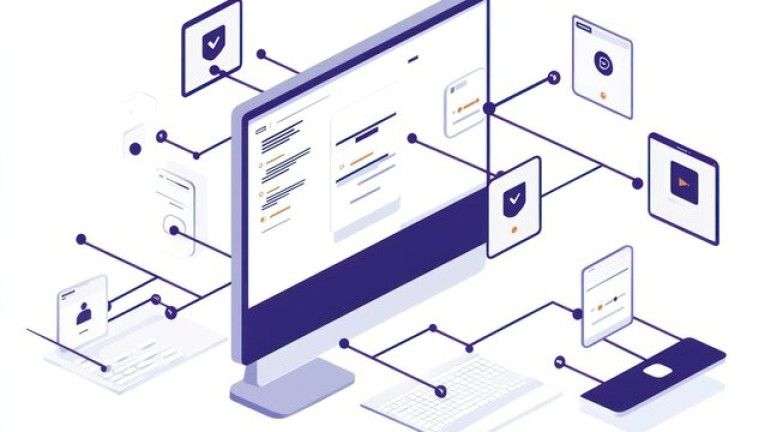Blockchain technology has undergone significant evolution over the past decade. As the demand for more scalable, flexible, and user-friendly solutions grows, new ideas have emerged to address these challenges. One such innovation is “account abstraction.” In this article, I’ll take a deep dive into what account abstraction in blockchain means, why it matters, how it works, and its potential impact on the future of blockchain networks.
Table of Contents
What is Account Abstraction?
At its core, account abstraction is a concept that aims to make blockchain accounts more flexible by decoupling the logic of user accounts from the protocol itself. It allows for the implementation of custom rules and operations on blockchain accounts, enabling more control and functionality for developers and users alike. Simply put, it shifts the responsibility for transaction validation from the blockchain protocol to the user or a contract.
To better understand account abstraction, let me start by explaining the difference between two key types of blockchain accounts: externally owned accounts (EOAs) and contract accounts (CAs). EOAs are the accounts controlled by private keys, while CAs are controlled by smart contract code. Traditional blockchains, like Ethereum, have a rigid distinction between these two types of accounts. Account abstraction seeks to blur the lines between EOAs and CAs, making accounts more dynamic and adaptable.
The Need for Account Abstraction
Blockchain networks have always faced challenges in scalability, usability, and flexibility. Here are a few key reasons why account abstraction has gained attention:
1. Limited Flexibility of Externally Owned Accounts (EOAs)
EOAs are typically limited to basic functionalities. They require users to interact with a blockchain through a private key. While this setup is secure, it’s also rigid. Users can’t easily modify the rules or behavior of their accounts without introducing complexity or risk.
2. Complexity of Smart Contracts
Smart contracts are flexible but can be complex and expensive to interact with. Users often need to deal with gas fees and other complexities that are not always necessary. By abstracting the account layer, developers can create custom logic that allows for more user-friendly interactions with smart contracts.
3. User Experience Improvements
Current systems require users to manage complex operations like gas fees, private keys, and transaction signatures. Account abstraction aims to simplify these tasks by allowing accounts to operate according to custom logic, potentially improving the user experience.
4. Unlocking New Use Cases
Account abstraction opens the door to new possibilities, including more complex multi-signature wallets, smart contract-based access control, and even the ability for non-cryptocurrency users to interact with blockchain networks.
How Does Account Abstraction Work?
Account abstraction works by altering the way transactions are validated and processed on the blockchain. In traditional Ethereum, for example, when a user initiates a transaction, their private key signs it, and the transaction is validated according to a fixed protocol. This process is limited because the account logic is tied directly to the protocol.
With account abstraction, the transaction process becomes more flexible. Instead of relying on the protocol to validate transactions based on the user’s private key, account abstraction allows for the introduction of custom validation logic. The blockchain protocol itself becomes agnostic to the type of account involved, allowing for more complex operations like:
- Multi-signature setups: Accounts could require signatures from multiple parties to validate a transaction.
- Custom transaction validation: Developers can design custom rules for how transactions should be validated.
- Gas abstraction: Users could pay transaction fees in tokens other than the native blockchain currency (e.g., Ethereum gas fees could be paid in stablecoins).
Account abstraction, therefore, provides an opportunity for developers to design new types of accounts with customized behaviors, making blockchain networks more versatile.
The Technical Aspects of Account Abstraction
From a technical perspective, account abstraction can be implemented in several ways. Let’s break down the fundamental components that contribute to its implementation.
1. Smart Contract-Based Validation
In an account abstraction system, transactions are validated by smart contracts rather than directly by the blockchain protocol. Smart contracts can be written to define custom validation rules. For example, a smart contract could specify that a transaction should only be valid if a certain threshold of signatures is met, or if specific conditions are fulfilled (e.g., a certain time has passed).
2. User-Defined Gas Payment
Traditionally, gas fees are paid in the native blockchain token (such as ETH for Ethereum). However, with account abstraction, users can pay transaction fees in other tokens, including stablecoins or even through third-party payment providers. This flexibility can improve usability, particularly for users who might not want to deal with fluctuating gas prices.
3. Meta-Transactions
Meta-transactions are transactions that are signed by a user and then sent to the blockchain via a third party. Account abstraction often uses meta-transactions to improve user experience. This way, a user does not need to directly interact with the blockchain or deal with gas fees. Instead, a third-party relayer can pay the fees and submit the transaction on their behalf.
4. Custom Account Logic
In traditional blockchain systems, accounts are fixed, with the only logic being the signing of transactions. Account abstraction allows for the development of custom logic that controls an account’s behavior. This could include adding functionalities like:
- Conditional logic (e.g., only allowing a transaction if a certain condition is met).
- Automated transaction execution based on triggers (e.g., sending funds at a certain time).
5. Cross-Chain Interoperability
Another advantage of account abstraction is that it could facilitate cross-chain interactions. With abstracted accounts, users could interact with multiple blockchains without needing to switch between different accounts or pay fees in different tokens. This functionality can play a major role in enhancing the interoperability of blockchain ecosystems.
Use Cases and Examples
Now that we’ve explored the theory behind account abstraction, let’s look at some real-world use cases and examples where this concept could have a significant impact.
1. Multi-Signature Wallets
Multi-signature wallets are an ideal example of how account abstraction can be used to enhance security. In traditional systems, setting up a multi-signature wallet requires the creation of a contract account. With account abstraction, the rules for signing transactions could be incorporated directly into the account itself, making multi-sig wallets easier to use and more flexible.
For example, let’s consider a company that wants to require three signatures from five board members before a transaction can be executed. With account abstraction, this logic can be implemented directly into the company’s blockchain account, allowing for seamless approval and execution of transactions.
2. Paying Gas Fees with Stablecoins
The volatility of transaction fees on networks like Ethereum is a known challenge. With account abstraction, users could pay their gas fees using stablecoins, rather than having to worry about fluctuating gas prices. This could create a much smoother user experience, especially for everyday users.
For example, if gas prices on Ethereum rise sharply, users could still pay for transactions with a stablecoin like USDT, avoiding the unpredictable price swings of ETH.
3. Customized Account Behavior for DApps
Decentralized applications (DApps) could benefit greatly from account abstraction. Developers could create custom account types with specific functionalities tailored to their DApp’s needs. This could include things like:
- Allowing users to authorize transactions based on certain criteria.
- Creating accounts that automatically execute trades or other operations at pre-set times.
- Integrating with external systems to pay for transaction fees or other services.
Comparison of Traditional and Abstracted Accounts
To help visualize how traditional accounts differ from abstracted accounts, here’s a comparison table:
| Feature | Traditional Account (EOA) | Abstracted Account (Account Abstraction) |
|---|---|---|
| Account Type | Externally Owned Account (EOA) | Smart Contract-based Account |
| Account Control | Private Key | Custom Logic (smart contract validation) |
| Transaction Validation | Fixed protocol-based | Customizable rules via smart contract |
| Gas Payment | Native token (e.g., ETH) | Can use multiple tokens (e.g., stablecoins) |
| Flexibility | Limited | Highly flexible with user-defined logic |
Benefits of Account Abstraction
The benefits of account abstraction are numerous. Some of the key advantages include:
1. Increased Flexibility
As we’ve seen, account abstraction allows for greater customization. Users and developers can design accounts with specific behaviors that suit their needs, rather than being constrained by predefined protocols.
2. Improved User Experience
Account abstraction has the potential to make blockchain networks more accessible. By allowing for easier gas payments and enabling features like meta-transactions, account abstraction can streamline interactions with blockchain networks.
3. Enhanced Security
Custom validation logic means that security rules can be fine-tuned to the specific needs of the account. For example, multi-sig requirements can be enforced more easily, and conditions for transaction approval can be made more complex and secure.
4. Cost Efficiency
Account abstraction could lower the costs of interacting with smart contracts by allowing users to pay fees in tokens other than the native blockchain currency. It can also reduce the need for users to interact directly with smart contracts, lowering transaction costs.
The Future of Account Abstraction
The future of account abstraction is bright. As blockchain technology continues to mature, it’s likely that more networks will adopt account abstraction principles to improve scalability and user experience. Account abstraction could lead to more innovative use cases and allow for the development of blockchain systems that are more adaptable to different types of users.
Blockchain projects like Ethereum and others are already experimenting with account abstraction through initiatives such as Ethereum’s EIP-4337, which aims to bring account abstraction to the Ethereum ecosystem. As these efforts progress, account abstraction could become a standard feature of blockchain networks.
Conclusion
Account abstraction is a powerful concept that can significantly enhance the functionality of blockchain accounts. By allowing for customizable account behavior, it enables more flexible, secure, and user-friendly blockchain interactions. Whether it’s through more efficient multi-signature setups, simplified gas payments, or the creation of custom account logic, account abstraction holds the potential to transform how users and developers interact with blockchain networks. As the technology matures, it will likely pave the way for new use cases and innovations that were once thought impossible.
With account abstraction, the blockchain world becomes more adaptable, opening the door to new possibilities and a more inclusive ecosystem.





